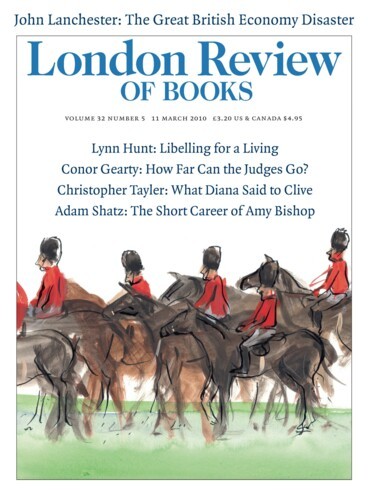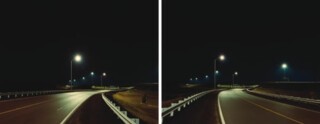Crash, a homage to J.G. Ballard (it takes its name from his 1973 novel), runs at the Gagosian Gallery until 1 April. Work by 52 artists starts in the lobby with a 3.5-metre-wide photograph of a Boeing 747’s undercarriage – part of Adam McEwen’s Honda Teen Facial. There are paintings with people in them, not all recent: a Delvaux of nudes in a blue room; a Hopper of a woman in an empty theatre; Witness, a smashed face by Jenny Saville; and John Currin’s Rotterdam – pornography as Norman Rockwell might have painted it. There are installations, such as Damien Hirst’s table of surgical instruments below photographs of a smashed eye and smashed limbs. There are DVD projections and sculpture.
This disparate collection has been selected (and in some cases created) as a response to Ballard’s ‘enormous cultural significance’. It aims to illustrate ‘a dystopian vision of the present and future which is the prevailing landscape for a wide range of artists working today’. Ballard’s creation of worlds in which something nasty is heaving under the glossy surface of modernity, and his interest in art, made explicit here through the inclusion of work by people he admired, are what hold it together. Many individual pieces have identifiable connections with his novels and journalism, and extracts from his writings are printed in large type opposite illustrations in the catalogue. Some are appropriate glosses on a style: Rauschenberg’s Jockey Cheer Glut, a downright jolly assemblage of yellow and red scrap metal, is set against a sentence from one of the stories in Terminal Beach: ‘Pop artists deal with the lowly trivia of possessions and equipment that the present generation is lugging along with it on its safari into the future.’ Others remind you that the dystopian world has its pleasures. On the page facing Allen Jones’s Archway (a sculpture in the Heathrow Hilton, Ballard’s favourite London building), you read that ‘sitting in its atrium one becomes, briefly, a more advanced kind of human being. Within this remarkable building one could never fall in love, or need to.’ Even when the overlap between a work and anything Ballard wrote is accidental, or vague, there is common ground in his attention to the look of things. He saw them as a painter might. His language was precise and often technical: his vocabulary when cars are involved is that of a maintenance manual; his sex scenes look like an atlas of anatomy.
‘I’ve always wanted really to be a painter,’ he said in 1975. ‘My interest in painting has been far more catholic than my interest in fiction … I’ve said somewhere else that all my fiction consists of paintings. I think I always was a frustrated painter.’ He not only envied visual artists, he believed in their power. ‘I didn’t see exhibitions of Francis Bacon, Max Ernst, Magritte and Dalí as displays of painting,’ he wrote in 2003. ‘I saw them as among the most radical statements of the human imagination ever made, on a par with radical discoveries in neuroscience or nuclear physics.’
In 1995, in the introduction to a new edition of Crash, he made wider claims for his own art: ‘Needless to say the ultimate role of Crash is cautionary, a warning against that brutal, erotic and overlit realm that beckons more and more persuasively to us from the margins of the technological landscape.’ In the catalogue Will Self writes of Ballard’s ability to see the nature of what has grown up around us: ‘Bleak man-made landscapes, technological, social and environmental developments and their psychological effects – these are aspects of the dystopian society we all live in now. Ballard may have started out as a science fiction writer, but his texts now read as social fact.’
When you pick up the daily paper and read of casual violence on a run-down estate or see plans for a new road, hypermarket or runway, it is easy to feel Ballardian anxieties, but the effect of the pieces at Gagosian is more fanciful and stylish than critical. The gallery – high white rooms, attendants in black – is itself a bit Ballardian, and the works, like old pictures of St Anthony taunted by devils and caressed by sirens, offer the eye lubricious, melancholy or violent bait that you can take without finding when you do that you have sprung a trapdoor into a deeper, darker reality.
This means that while some of the non-human subject matter in the exhibition consists of decayed, fractured, faded or crushed examples of things (cars, skyscrapers, rocket gantries) that normally dwell in images of 20th-century utopias, the scenes of destruction are altogether less violent than a bald description would suggest. You can’t look at the images of blown-up buildings as they collapse among smoke and falling masonry, in Richard Artschwager’s Destruction III or Rachel Whiteread’s Demolished, without remembering that when a tower block gets the chop it is a rather cheerful affair – a bit of light relief at the end of the news, as often as not taking place with a cheering crowd in the foreground.
Tacita Dean’s photograph of Donald Crowhurst’s Teignmouth Electron abandoned in the Caymans is, if anything, wryly anecdotal. Dan Holdsworth’s Untitled (Autopia), night photographs from each side of an empty stretch of motorway, is quiet and elegant – with the implication that something just may be about to happen. Bland stylishness is not surprising in the work of someone who is also a commercial photographer. Helmut Newton’s black and white photograph of a beautiful, undressed woman in an overdressed apartment wearing only surgical back and neck-braces, a suspender belt and black stockings might seem to illustrate a change in sensibility like the one Ballard identifies in an essay on Dalí (‘demise of feeling and emotion has paved the way for all our most real and tender pleasures – in the excitements of pain and mutilation’), but Newton was a fashion photographer and his elegant soft porn is easy to read as evidence of the retreat of censorship which has allowed images that would once have been herded towards the margin or underground to sprout up in every part of the visual culture. High art now has a hard time finding borders to transgress.
Ballard’s sense of something wrong with the world our appetites and ingenuity have created makes ordinary things – suburbs, roads and high-rises – look different, as they might in the lurid glow of an approaching storm. It is a gift to art that has been appreciated.
Send Letters To:
The Editor
London Review of Books,
28 Little Russell Street
London, WC1A 2HN
letters@lrb.co.uk
Please include name, address, and a telephone number.


